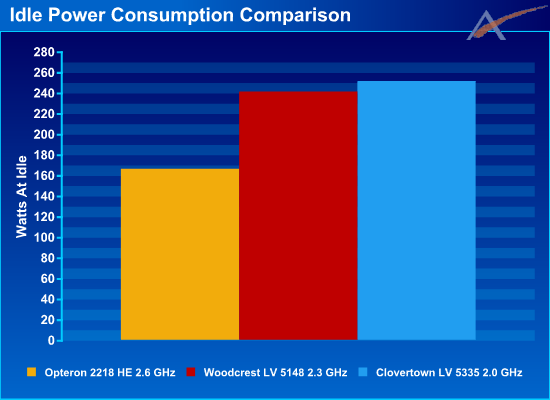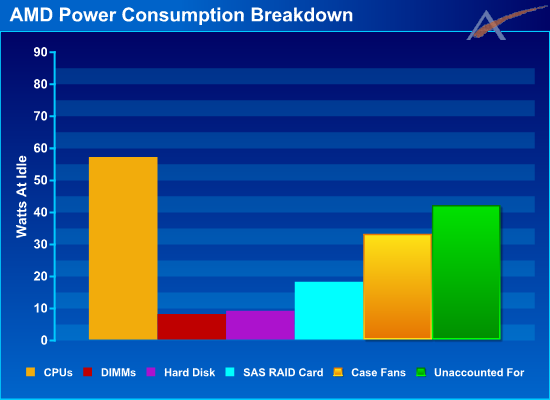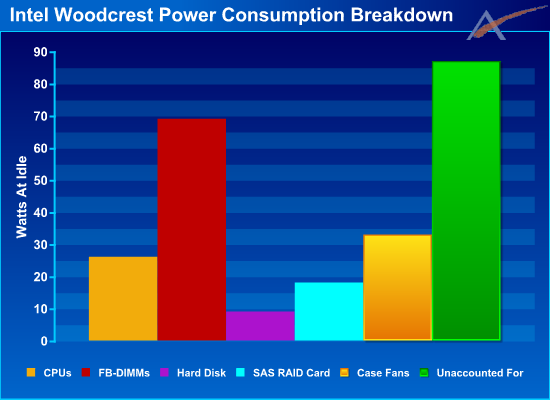Low Power Server CPU Redux: Quad-Core Comes to Play
by Jason Clark & Ross Whitehead on September 13, 2007 6:05 AM EST- Posted in
- IT Computing
Benchmarking Low Voltage
Since this article is focused on low power parts and that market is mostly focused on Performance/Watt, we decided we would only report results with all power management features enabled. To configure our servers with all power management features on, we perform the following:
On Intel
In the BIOS ensure that Thermal Management is On/Enabled, C1 Enhanced Mode is On/Enabled, and EIST Support is On/Enabled.
On AMD
In the BIOS ensure that PowerNow is On/Enabled. Additionally, you must install the Processor Driver, from AMD, in your OS.
For both platforms you must also set the Power Options in Control Panel to "Server Balanced Processor Power and Performance".
For details about the impact that the Power Management features had on a system at idle please see our previous article. With all Power Management features turned on we recorded idle power usage for all three systems.

We see that AMD has the lowest idle power consumption. Intel's Woodcrest system uses approximately 41% more power at idle, and the Clovertown system uses approximately 51% more power at idle. The Clovertown system only uses approximately 4% more power at idle than the Woodcrest system, which is not bad considering it has twice as many CPU cores.
During the testing, we often speculate about where all the power goes. We attempted to find out by measuring power consumption of the entire system at idle, then removing a component and re-measuring the power consumption. The difference in power can be attributed to the removed component. This is not a perfect way to determine component power requirements, but it does provide some general guidance as to where all of the power goes. The results are very interesting:

In the AMD system we see that the bulk of the power is consumed by the idle CPUs. Overlooking the "Unaccounted For", the next biggest consumer is the five case fans, followed by the SAS RAID Card. The "Unaccounted For" is everything which is not listed, including the inefficiency of the power supply and the motherboard and chipset.

In the Intel Woodcrest system we see that the CPUs require significantly less power than the AMD CPUs, 54% less to be exact. On the other hand the FB-DIMMs require 862% more power than the AMD DIMMs. (Yikes!) Also, the "Unaccounted For" is twice as high on the Intel system as the AMD system. Keep in mind both of these systems have identical power supplies, so the efficiency is roughly the same.

The Intel Clovertown system is identical to the Woodcrest system except for the CPUs, which require approximately 4% more power at idle.
Choosing the contenders
In previous articles, we've been asked to explain why we chose the parts we did for an article. For this article we used the latest low voltage quad-core parts from Intel and the latest low power dual-core parts from AMD. The first question that may come to mind is, "Why are you comparing a quad-core part with a dual-core part?". The answer is quite simple: for Intel the two quad-core / dual-core parts we're comparing cost about the same, so while the parts we are comparing aren't equal in terms of the number of Cores, they are equal in terms of price. On the AMD side of things, the CPU price is once again similar, but other than the just-released Barcelona there are no quad-core AMD offerings. Since testing for this article began over a month ago, including Barcelona wasn't an option at the time.
Since this article is focused on low power parts and that market is mostly focused on Performance/Watt, we decided we would only report results with all power management features enabled. To configure our servers with all power management features on, we perform the following:
On Intel
In the BIOS ensure that Thermal Management is On/Enabled, C1 Enhanced Mode is On/Enabled, and EIST Support is On/Enabled.
On AMD
In the BIOS ensure that PowerNow is On/Enabled. Additionally, you must install the Processor Driver, from AMD, in your OS.
For both platforms you must also set the Power Options in Control Panel to "Server Balanced Processor Power and Performance".
For details about the impact that the Power Management features had on a system at idle please see our previous article. With all Power Management features turned on we recorded idle power usage for all three systems.

We see that AMD has the lowest idle power consumption. Intel's Woodcrest system uses approximately 41% more power at idle, and the Clovertown system uses approximately 51% more power at idle. The Clovertown system only uses approximately 4% more power at idle than the Woodcrest system, which is not bad considering it has twice as many CPU cores.
During the testing, we often speculate about where all the power goes. We attempted to find out by measuring power consumption of the entire system at idle, then removing a component and re-measuring the power consumption. The difference in power can be attributed to the removed component. This is not a perfect way to determine component power requirements, but it does provide some general guidance as to where all of the power goes. The results are very interesting:

In the AMD system we see that the bulk of the power is consumed by the idle CPUs. Overlooking the "Unaccounted For", the next biggest consumer is the five case fans, followed by the SAS RAID Card. The "Unaccounted For" is everything which is not listed, including the inefficiency of the power supply and the motherboard and chipset.

In the Intel Woodcrest system we see that the CPUs require significantly less power than the AMD CPUs, 54% less to be exact. On the other hand the FB-DIMMs require 862% more power than the AMD DIMMs. (Yikes!) Also, the "Unaccounted For" is twice as high on the Intel system as the AMD system. Keep in mind both of these systems have identical power supplies, so the efficiency is roughly the same.

The Intel Clovertown system is identical to the Woodcrest system except for the CPUs, which require approximately 4% more power at idle.
Choosing the contenders
In previous articles, we've been asked to explain why we chose the parts we did for an article. For this article we used the latest low voltage quad-core parts from Intel and the latest low power dual-core parts from AMD. The first question that may come to mind is, "Why are you comparing a quad-core part with a dual-core part?". The answer is quite simple: for Intel the two quad-core / dual-core parts we're comparing cost about the same, so while the parts we are comparing aren't equal in terms of the number of Cores, they are equal in terms of price. On the AMD side of things, the CPU price is once again similar, but other than the just-released Barcelona there are no quad-core AMD offerings. Since testing for this article began over a month ago, including Barcelona wasn't an option at the time.










36 Comments
View All Comments
Justin Case - Saturday, September 15, 2007 - link
Could Anandtech restrict the advertising to the banners? Editorial advertising forces poor ad-blocker programmers to work overtime.First, right after the Barcelona (AMD quad-core) launch, we get an article titled "Quad core comes to play"... that pits Intel quad-core CPUs against AMD dual-core ones (published *after* AT covered Barcelona, in Johan's article). Secondly, the article ends with a link to the "Intel resource center". Finally, the article's icon, which contains AMD's logo, links to Intel's site.
Proteusza - Saturday, September 15, 2007 - link
I think Anandtech knows which side of its bread is buttered.Frumious1 - Saturday, September 15, 2007 - link
You people - and you especially, Mr. Justin Case who LOVES AMD - are pathetic. "It's so unfair - AMD tries so hard and they have their quad core part shipping now and AnandTech intentionally published an article they had worked on for weeks right after the K10 launch in order to slight AMD!" Care for some cheese with your whine?I guess I'm one of the few that can read all of the articles here and see what ISN'T explicitly stated? How about this one from Anand's Phenom "performance estimate":
Now let me tell you, as an IT guy that is ABSOLUTELY INSANE! We are talking an enterprise part, and it died during testing. Read the pre-launch articles as well, and you get the impression that AMD is scrambling like crazy to rush this out the door, that they've had all sorts of difficulties, and that at best Barcelona/Phenom need a few more months in the oven before they're fully baked. I can't even imagine any large corporation seriously considering Barcelona with statements like that, at least not until the BIOS revisions and everything else are worked out. But hey, let's let the blind AMD fanboys complain about biased coverage because Anand and company didn't run additional tests on a Barcelona server that broke down during testing!
You know what would be fair? It would be fair if Anand basically ripped AMD a new one and said what a complete joke the Barcelona launch has been. They got "final" CPUs one week before the launch: "We went from no Barcelona, to fist-fulls of Barcelona in one weekend." Ask any of the tech people out there when they first saw Harpertown CPUs in house. Yes, a product that hasn't been officially unveiled yet, and I'd bet there are thousands of the processors in the hands of testers, businesses, reviewers, etc. But AMD is freaking awesome because they made a new processor.
AMD having problems isn't the fault of Intel, Anandtech, NVIDIA, or anyone but AMD. They are failing to execute, they are missing windows of opportunity, and all the fanboys can do is try to find any excuse to blame someone other than the real culprits. AMD has issues right now, they are losing money, and it doesn't look like Barcelona is going to do anything beyond maintaining parity at best. Why don't you complain about people not benchmarking with the cherry picked 3.0GHz Barcelona chips that aren't on any roadmaps for the next year while you're at it? Complain about the unfair comparisons where a $350 Barcelona is compared to a $350 Clovertown, because the Intel chip runs at a 20% higher clock speed?
Again: pathetic. That's all your diehard AMD dedication is. If they had the better processor, that would be great, but it appears that they don't and very likely they won't for a long time. Frankly, I'm not sure they can survive the coming years if they continue their present trend. Hopefully IBM can bail them out (again).
Proteusza - Sunday, September 16, 2007 - link
Its got nothing to do with love for AMD or Intel.Had the situation been reverse, I would have said the same thing. The article's title is quad core comes to play. Now, as far as I see it, that can be interpreted in one of two ways:
1. Intel has just brought out their new quad core cpus so we can finally test them against AMD's dual core cpus.
OR
2. AMD has just released their quad core cpus, so we can finally test quad core cpus from both manufacturers.
Now, we know that 1. is false because Intel has had quad core cpus for over a year or something. And we know that 2. is also false because AMD's quad core cpus werent tested in this article.
So, at the end of the day, we have a meaningless title. Quad core comes to play? Duh its been out for ages.
In any case, I dont think that Anandtech are biased towards Intel. Oh no, I think they are just paid to do advertising articles sometimes. Like almost all sites. Look at this article: it comes out within days of AMD launching its server quad core cpus, the AMD/Intel logo goes to Intel's site, there is an Intel resource centre link at the end of the article. Too many coincidences for me to think this isnt anything but advertising.
Again, I will state I enjoy cpus from both manufacturers, and I have no preference. But this is just poorly disguised advertising. Had I known less about cpus, I would have thought the CPUs being tested were Barcelona cpus, and that it was found that Intel were better. You'd be surprised what people pick up from skimming over articles.
iceburger - Monday, September 17, 2007 - link
IMHO the article was not really biased - it only convinced me that intel doesn't have such a great "low power" processor unless the load is kept high through virtualization, because in the real world there aren't that many servers that run at 100% 24/7. It was ok up until the "intel resource link"...and then I found out about the logo.........Now how much are THEY paying for each click-$0.25? $0.30?
Wow...I'm speechless.
But it fits the bill- intel is the one that pays Google to advertise them when you search AMD. Why would I not think that AT is on someone's payroll? Not a real surprise- following steadily into THG shoes- away from enthusiast site , closer to click generator.
One step closer to deleting my bookmark.
JarredWalton - Tuesday, September 18, 2007 - link
Despite what you may think, the advertising is totally separate from any editorial content. I have no idea who even advertises with us, and there has never been any suggestion of doing a good review for an advertiser - quite the opposite in fact. I have heard it specifically stated more than once, "Just because [company X] wants us to look at a product doesn't mean we need to do so. If it's interesting, then fine, but we are not an extension of the marketing departments."Now, obviously Intel is an advertiser; no surprise there since they advertise with just about every hardware site out there. Do they pay extra for a link that says "Intel Resource Center" at the end? Probably - I don't even know - but that link is automatically inserted by the document engine whenever we (or really I, given I'm the content editor) select Intel as the manufacturer on an article. As for the logo... well, that's tied to the same thing.
I have now changed the manufacturer to "Various" as opposed to Intel, which makes the logo do... nothing, other than take you back to the main AT page. (I wish we got paid for every click on that....) I didn't really think about it when posting the article, and since it was primarily an update of the Dual-core results only with an Intel Quad-core CPU, I figured it was sensible that Intel was the primary manufacturer and set it accordingly. Thus, the logo took you to the Intel site, just like the logo in my review of the HP Blackbird 002 links back to HP when you click it.
Sorry for the confusion, but the conspiracy theories are unfounded. Back to your regularly scheduled articles, and feel free to check back tomorrow afternoon for a continuation of this series.
Take care,
Jarred Walton
Senior Editor
AnandTech.com
JarredWalton - Sunday, September 16, 2007 - link
See above. The actual title is: "Low Power Server CPU Redux: Quad-Core Comes to Play" Note the Low Power part; the Xeon L5335 L5320 and L5310 are indeed newer parts - the L5335 in particular. We looked at LV Xeon and Opteron last time (something like SIX MONTHS after the parts were initially released), so the fact that this article continues from that point as opposed to the latest Barcelona isn't particularly relevant. Different editors, different testing procedures, different locations. Barcelona and Harpertown testing for a future article are in progress... which means not done, which is why this article was posted now without such information. I'd love to get all the latest data for every option out there "yesterday" as well; unfortunately, reality isn't so easy.Justin Case - Saturday, September 15, 2007 - link
I "love" AMD about as much as I love any other mega corporation (which is to say very, very little). I buy whichever CPUs give better performance per dollar or (in very rare situations) better performance per watt. Right now that means Intel for laptops and 1S workstations, AMD for servers, and either one for midrange desktop systems.What I definitely do not love is the way some of the main "hardware review" websites have turned into an extension of the manufacturers' marketing departments, basically publishing press releases, fake "reports" and "editorial" ads. Hardware review sites are supposed to be allies of the consumers, not allies of the industry.
If it wasn't for Anand's and Johan's articles (and the comments from a small number of smart and informed people), this site wouldn't be worth reading at all, these days.
formulav8 - Friday, September 14, 2007 - link
Just somewhat curious as to why the hybrid AMD/Intel Logo on each page of the review next to the author info has a link that goes to Intels site? Obviously anand can do what he wants, I just saw it as kinda wierd that a hybrid logo with AMD on it would go to Intel? :?jason
steveha - Friday, September 14, 2007 - link
How about adding Q6600 based 1U server into the mix this takes the good parts of boths systems, Low usage Intel CPU and Low usage DDR yet still gives 4 * 2.4Ghz Cores.